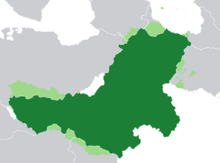Luepolan language: Difference between revisions
Jump to navigation
Jump to search
No edit summary |
No edit summary |
||
| Line 37: | Line 37: | ||
| agency = Academic Society for the Luepolan Language | | agency = Academic Society for the Luepolan Language | ||
| map = Luepolan language map.png | | map = Luepolan language map.png | ||
| mapcaption = {{legend|#1b8036|Areas where Luepolan is spoken by over 50% of the population}} | | mapcaption = <small>{{legend|#1b8036|Areas where Luepolan is spoken by over 50% of the population}}{{legend|#9ed989|Areas where Luepolan is spoken by at least 10% of the population}}</small> | ||
}} | }} | ||
Revision as of 17:50, 16 July 2019
This article is incomplete because it is pending further input from participants, or it is a work-in-progress by one author. Please comment on this article's talk page to share your input, comments and questions. Note: To contribute to this article, you may need to seek help from the author(s) of this page. |
| Luepolan | |
|---|---|
| Ľupolski Ľupolski Ézik | |
| Native to | Luepola |
Native speakers | 83 million (2013) |
| |
| Official status | |
Official language in | |
Recognised minority language in | |
| Regulated by | Academic Society for the Luepolan Language |
| Language codes | |
| ISO 639-3 | lup |
 Areas where Luepolan is spoken by over 50% of the population Areas where Luepolan is spoken by at least 10% of the population | |
Luepolan (/luːˈpoʊlən/; Luepolan: Ľupolski, /ʎupɔlski/) is a South Slavic language that originates in eastern Patyria. It is spoken by approximately 83 million speakers worldwide, the majority of whom live in Luepola, where it is the sole national language.